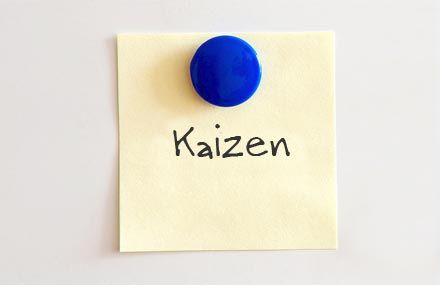
Kaizen is a Japanese management concept that aims at the gradual and continuous improvement and perfection of processes. It combines the Japanese Words “Kai", representing change, and "Zen" representing „for the better". Kaizen is generally not applied globally, but rather in the area of activity of every individual on every level.
In Europe, Kaizen has been applied since the early 1990s, mostly under the term of "continuous improvement process" and is based on the following guiding principles:
- Good processes to achieve good results
- Taking measures to contain and correct the basic causes of problems
- Documentation of the current situation
- Teamwork
- Integration of all employees
Key fundamentals of Kaizen
Standardisation
If a proposed improvement suggestion is suitable for a company, it will be defined as a standard and integrated into the existing processes. The PDCA-Cycle transforms therefore to SDCA (Standardise, Do, Check; Act). As soon as the process is completed, a further improvement is addressed.
Criticism
Criticism is viewed as an opportunity for continuous improvement. Therefore, every employee should be encouraged to come forward with suggestions for improvement. The company should take up these suggestions constructively and try to implement them in the best possible way. This results in a continuous cycle of planning, doing, checking and improvement. (in short: PDCA Cycle: Plan-Do-Check-Act)
Quality orientation
JEach company defines its own standards of quality, which will be transferred onto the quality requirements for (of) activities and processes.
Customer orientation
In Kaizen, the company is focused on customers and their needs and expectations. A distinction is made here between external and internal customers. External customers act outside their own enterprise. Internal customers on the other hand are within the company e.g. their own colleagues, who receive the service. Since every activity in the company is regarded as a customer-supplier service, the company thus appears to be very customer-oriented. At the same time, this corporate culture requires each employee to critically examine, analyse and improve his or her own performance.
Process orientation
The process orientation helps, due to the continuous improvement, to make processes manageable controllable. An improved process automatically leads to better results. The process optimisation therefore has to take place on a regular basis, enabling flexible and quick reactions. Adhering to these guidelines increases value creation, reduces waste, and defects at the same time.
Objective
Kaizen purses the following goals:
- - Guaranteeing quality from the beginning
- - Standardisation dof work operations by identification of tasks and correct adherence to self-imposed standards
- Avoidance of waste of resources ( time and material)
- - Independent identification and elimination of weak spots
Preconditions
Kaizen involves a cooperative management style. This means that leaders and employees work closely together both in the development of ideas and in the implementation of projects, and complementing each other in their competencies. Kaizen also has other aspects: intensive transfer of information from top down as well as vice versa. In addition, there is a joint, clear formulation of objectives and an understandable consensus instead of individual decisions made by the superiors.
Ideal conception
The ideal for Kaizen means tis to establish qualified, active, responsible and creative employees in the company. They receive a differentiated and individual recognition and financial remuneration for their performance. Kaizen therefore offers the opportunity to improve process structures within the company. Thanks to the continuous optimisation, this is reflected in quality, in the motivation of employees and the success.
>
Copyright © 2022
Lean Management Consulting
